Bike-friendly area
Recumbent and upright bike

Radius Hornet (I) short-wheelbase
Ergonomic vehicle in the non-virtual world (thus in First
Life). Not that it moves by its own, but even a cyclist without
athletic ambitions notices the difference. For instance if one
reaches an average speed of just above 20 km/h (12.5 mph)
with a (race) mountain bike, then one will achieve close up to 25 km/h
(15.5 mph) with a (tour) recumbent. Provided that it is an
adequate course, thus neither extreme off-road nor exclusively on
tar by head wind.
Cycling on a recumbent stresses the legs, however, anyhow it goes
easier. While one really feels a mountain bike tour of 100 km (about 62
miles), with the recumbent some additional ten miles are easily
possible.
The faster one can cycle the more advantage gathers on the side of
the recumbent. A recumbent without fairing is somehow comparable
with a racing bicycle. A completely streamlined recumbent is not to
beat - almost any speed record is held by recumbents. But they have
their weight and their price.
Concerning my touring recumbent: in the same tarred drop about
55 km/h (approx. 34 mph) are possible on the mountain bike
in racing position out of the ride, with the just rolling recumbent
easily more than 80 km/h (approx. 50 mph). Guys on racers
tell me it significantly starts to roll them away at about
35 km/h (about 22 mph) downhill. (That means, however, I'll
really have to speed if I want to benefit from that in the plain.
And I don't intend to take ASPIRIN™ Drive or anything
similar...)
External view - the best comment up to now: »Is this a solar
mobile?
« - (Well, if you drive in the sun you'll get brown.
Or even red at first. ;-)
The a bit different bike - recumbent
The advantages
-
The relaxed sitting position permits a comfortable ride and a great view. Gentle to the backside and also one's wrists are relieved.
Thus long lasting tours, even without intermediate rest day between, are possible. -
The reduced wind resistance improves the average and maybe the maximum velocity.
Combined with the relaxed sitting position this increases the range per tour and day by day. -
In a frontal crash the crush section starts far away from one's nose. (And one does not fall so deep.)
The disadvantages
-
Difficult (better: unfamiliar) to ride. Due to the low center of gravity a correction of driving faults by balancing with the weight is hardly possible and riding a mid or low racer turns need to be prepared (steer opposite and then tilt into the turn). Usually the rear wheel is biased with reduced weight and rather tends to skid - caution on binderless gravel and wet leaves.
Overall less physically but mentally demanding. -
No sight over parking cars, fences, etc. and one is hard to see - but easy to kill. (What's about a pennant?) Therefore a recumbent is not the first choice for an urban bike. Further more it cannot really show its advantages in frequent stop and go traffic and in tight turns.
-
There is no relief of the leg muscles by using the body mass. No chance to throw your weight on the pedal. So have much fun climbing up long hills. Above about 10% it starts to get really annoying, nevertheless, even 17% are feasible. And why not?
Tips
-
Riding a recumbent is different - therefore check during a longer test ride whether a recumbent holds what you are expecting.
Perhaps two-wheelers show somehow a bit rough run due to the twitch/torque of the back and forth moving legs - but you will internalize automatic countersteering very soon.
Center steering recumbents are a special theme, but interesting to ride (even without holding on!). -
In all probability slipping off the pedals of a two-wheeler results in a fall. Thus mount racing locks at least, namely such with plastic cage and loose tighten belts. Or just try click pedals (so-called »clipless« or »with cleats«; somehow similar to a ski binding). Not, however, the racing version, but e.g. SPD Shimano SM-SH55 plates with multi-exit option. Choose as pedals e.g. Shimano PD-M324, which can be used together with normal shoes, too. Therefore one can drive clicked out with them as well. In general one should note that depending of one's tour preferences due to more shifting phases, light and due to the cranking angle, flat, ankle-free mountain bike shoes are the better choice instead of pure racer shoes.
-
Revolutions is what you need, especially in slopes, i.e. restrictions in changing gear will get on your bones. Ensure to have enough gears. And note the gear boxes are usually pre-selected for speed and not for hill climbing. Forcefully uphill with less than about 8 km/h (about 5 mph) may causes inharmonic hack crankling and blind ambition will overstress your knees.
-
Possibly you lie in the sun like on a deckchair - danger of sunburn! And consider wearing (sun-) glasses with UV protection.
-
One additional note: beware of horses, with or without riders. They fear recumbents and even they bolt - especially when one uses a pennant. Although when one slowly approaches only or even stops. The critical distance is about 5 to 10 meters (15 to 30 feet).
He is just sleeping during cycling
First experience: Quantum Toxy

Early Quantum Toxy; here with rear case
Some selected
bike tours
in region Nuremberg:

MORE
Easy to handle - the full suspension Quantum by Arved
Klütz of those times was really good-natured. In spite of the
rather simple construction with a rubber buffer the rear suspension
proved very effective. Built with Al square tubes (unusual optics!)
the Quantum was comparatively light but yet stable.
After two test rides in March 1997, in all 90 km (approx. 56
miles) on the road and gravel, I was sure: I need a recumbent even
though I almost tipped over three or four times when stopping. (No
fallen angel, but bloody beginner.)
The present models clearly show the enormous technical progress,
see the link on the left.
The small 20 inch front wheel may show deficits in barrier
climbing (but one just rarely uses a recumbent in single
trails ;-), however, it supports agility and transportability. In
combination with adequate suspension reduced comfort does not
ensue.
To exhaust the roll performance on the road there are models with
big front and rear wheels (24 to 28 inches). But even velodrome
time trail machines show the classic short-wheelbase geometry -
small front, big rear -, even if they do not provide uniform small
wheels due to aerodynamic reasons (low rider!).
Traveling sedan chair: Radius Hornet Full Suspension
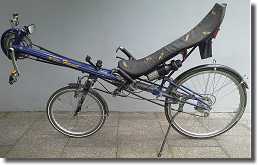
Radius Hornet (I) Full Suspension
Especially on pavement riding the Hornet is nearly more
comfortable than a mountain bike fully and concerning cross-country
capability it is in competition with a city/tour bike - so
sufficient enough for gravel paths in the forest or if need be for
field paths. Bikes of this short-wheelbase geometry are preferred
for long distance tours, even in countries providing not so good
transport connections.
With approx. 17.5 kg (approx. 35 pounds) rather heavy (CrMo
frame), but thanks to the in-ride lockable rear suspension
(really recommended) slops up to 15% are to be mastered with
bearable effort (what doesn't mean it is fun). And in opposite
direction the Magura HS11 hydraulic breaks reliably provide
safety.
The deep located indirect steering gear is very agreeable -
(nearly) always one gets one's feet on the ground just right in
time. Besides it provides a good protection against risk of injury
when upsetting. And it is extraordinary comfortable.
Result: a very elegant but robust and reliable bike with a lot of
intelligent detail solutions, which can be used almost
universally.
The own modifications like the small rear bag (standard frame bag)
and the two-part rear reflector and tail light combination centered
to the seat have been proven well. So has done the rear-view mirror
(wide angle car indoor mirror) at the derailleur tube as well. In
the drinking bottle with double bottom a cable lock and the patch
kit inclusive a telescope air pump are stowed away. The opposite
holder is foreseen for the real drinking bottle.
The only disadvantages are the 133 mm short modified dampener
(rear suspension) manufactured by Bitubo if it needs service at
all, and that one gets caught on the speedometer bar from time to
time. The speedometer is is located at the beam above the fork
head.
Since April 1997 the chaser in the speed limit area Zone 30 (km/h).
And concerning distance, almost one time around the world.
Hot wheels: HP Velotechnik Speedmachine
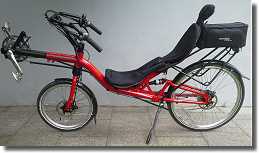
HP Velotechnik Speedmachine
Easy to see the HP Velotechnik Speedmachine is more
comparable to a racer than to a mountain bike. In fact made for tar,
however, it is not a pure racing machine, and one can ride it on
well graveled (read: sanded) paths with comfort and speed. Not
at least due to the excellent suspension and the low weight of the
Al/carbon frame below 15 kg (approx. 30 pounds) in ready to
ride condition. And even up the hills the Speedmachine convinces.
With its highly developed bag carrying capabilities it turns to a
very sporty long distance bike.
The upper »aero handlebars« may look strange, but permit an
easy getting on and off, offer a very comfortable seating position
and provides a good steering control. They do not excessively limit
the field of view. The ride is stable, fast and relaxed. The
Grip-Shifts perfectly fit to recumbent riding - one switches gears
intuitively and clean. Even through some gears at once. Some
special parts like carbon tube insert and light dampener support
weight (and money) reduction. Hub dynamo, LED lighting and
self-adjusting disc breaks are pure luxury, but effective and
carefree.
Result: a convincingly developed bike built on high quality level,
which invites you to speedy cruising.
The standard 15 liters (about 4 US gallon) bicycle fold rack bag in the slipstream of
the seat offers more than sufficient room for patch kit, air pump,
drinking bottle and other accessories. Speedometer and rear-view
mirror are mounted to the handlebars just in the range of view.
And the bell as well.
The sole disadvantage: the control cables could be routed a bit
better around the fork head in order to create more distance to
one's thighs.
Since May 2013 in running-in phase. And meanwhile running for the
pleasure.
Hornet versus Speedmachine
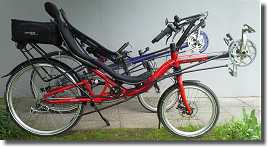
Hornet - Speedmachine: tourer vs. racer
Equivalent to the HP Velotechnik Streetmachine the Hornet provides a wheelbase about 15 cm (approx 5 inches) shorter than the Speedmachine and its seat is positioned with about 60 cm (approx. 23.6 inches) almost 13 cm (approx. 4 inches) above that of the Speedmachine. This makes it notable more nervous, its steering requires steady control. To leave the handlebars unattended just for less than one second makes a distinct intervention necessary. (And causes some cold sweat.) Nevertheless, one gets used to it very soon and will only take notice of it in direct comparison to the Speedmachine. One must literally force the later one into a curve - first swing to the outer side then tilt into the curve - whereby narrow curves (elbow to hairpin bends) afford attention, because it could occur to get into the way of the handlebars. Although the usual ride on tar or plain graveled paths is completely relaxed and a little bit faster. In the downhill test mentioned above the Speedmachine approaches almost 90 km/h (approx. 56 mph), about 8 km/h (approx. 5 mph) more than the Hornet. The Hornet, however, scores on loose gravel - any bumps are covered by automatic steering, concerning the Speedmachine on this (shaky) underground caution and concentration is indicated. And this although the Hornet offers smaller tires than the Speedmachine (but this would be easy to change).
High seat
Cycles with wolves: Steppenwolf Tundra FS
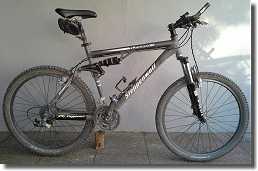
Steppenwolf Tundra FS
Tips for
cycling the Noris
(Nuremberg):

MORE
Else often I'm on tour otherwise, when it is stormy
weather or in snowy winters and for raging - live richly... And
meanwhile the Steppenwolf Tundra FS is switched to the new frame of
2007. However, I've chosen the Magura HS 33 hydraulic brakes
again.
Advantageous are the wiring exclusively at the upper tube, the
damper position out of the splash region and, of course, the low
weight Al frame. And the 26 inch wheels provide agility. Besides it
looks pleasant unobtrusive.
The switch from Grip-Shift towards Rapidfire levers takes a bit of
time. But the gear change works very fast and precisely.
(Especially when making up one's mind to grease and oil the sleeves
of the Bowden cables one recognizes where the name derives!) The
grip space and seat possibilities, however, are slightly reduced.
Therefore additional bar ends are recommended.
The small under saddle bag offers sufficient room for a patch kit
and a small mobile phone.
Really a very impressive vehicle, even hill-up. Besides a
good-natured, reliable and robust companion. On tour since May 2003
and also more than half way around the world.
Back in time: on the road again
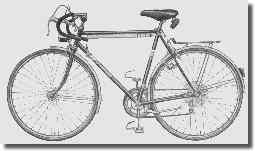
Hercules Saragossa
Even though the 1980s Hercules Saragossa ten-speed sport
bike showed some limitations I regret it somehow. In fact a bent wheel
was not so seldom, but it was easy to correct. Frame fracture was a
foreign word during seventeen years and umpteen thousands of miles. (Steel,
however, is better to weld than aluminum and shows more fatigue
strength.)
For the usual gravel paths it was sufficient enough by far
and it was in some kind the better tour bike, especially when
longer sections on tar were topic. And to tell the truth - how
often one breaks through mountain bike adequate heavy terrain?
Nowadays hollow section rims offer enough stability and the sprung
seat posts earn perfect scores, so that after the mountain bike era
a cross bike, better gravel jumper, is supposed to follow. An
unsprung, but fast and robust tour and trekking bike just for
various grounds. And if is just unavoidable, however, due to
advanced age, then with electric tail wind.
Just a matter of setup
Flight level
Exact saddle height, the distance between saddle and pedals, resp. - e.g. according to Handbuch Radsport, BLV, 1994, p. 44 - amounts to:
saddle height = standover x 0.893
measured between top level of saddle and middle of bottom
bracket.
And if no pocket rule is available at the moment? Adjust by just
putting your heel on the pedal with unbend leg. Then your leg is
not completely unbend when the ball of your foot hits the
pedal. Conventional bikes with diamond frame (inclusive mountain
bikes with Y frame) and recumbents do not differ herein.
You can calculate the frame height of a racer out of the standover
by a factor 0.65 and of a mountain bike by a factor 0.61.
Recumbents usually come in two manufacturer-specific sizes small
and large or short and long, resp.
Need for speed
Evoked by the small »experts« group long time ago -
gravel paths compared to tar cost 3 to 7 km/h (about 1.86 to
4.35 mph) average speed.
Three hours and 75 km (about 46.6 miles) with the ten-speed
sport bike through the Nuremberg forests almost exclusively on
gravel paths showed me that this speed makes one only busy with
cycling without any eye for the nature. Therefore I'd like to work
on my aerobic base fitness with a joyful song on my lips.
According to the source above (p. 198) one can estimate this region
using the pulse frequency:
Heart rate for 60% physical exercise = 0.6 x (220 - life years)
Below 50% it won't pay, above 70% it will dwindle into work. (That's not to say I'm not on the move with maximum warp sometimes. And with up to 9 000 km (about 5 0000 miles) per year - if it has been going very very nicely - there has been a little bit to come. ;-)
Revolution!
Except for training with about 120 revolutions per minute (rpm) pros crank on a mountain bike with about 90 rpm, on a racer (and recumbent) with about 100 rpm. Of course, climbing up a hill can bring reduction. (Concerning me a cadence of above 60 rpm is just enough in the plain so far.)
Last but not least
To external bike links:

Links
Example recumbent does not exist, just as little the
conventional upright bicycle exists. In fact the wealth of variants
is even bigger. The range covers the two wheel racing weigh,
possibly with (partly) streamlined fairing, and the three-wheel
urban and shopping vehicle as well. Also four-wheel versions and
tandems are available. Even suspension, front-drive and motor are
not unusual.
If money plays no role, weight will be not a problem. Easily
carbon can significantly push the empty weight below 10 kg
(about 22 lb). Otherwise one enters with bicycles without fairing
the region of about 15 ± 3 kg
(about 33 ± 6.6 lb). Trikes easily reach 5 kg
(about 10 lb) more.
Exciting, despite all prophecies of doom it is no problem to climb hills
exceeding 10% incline (18% are not funny with mountain bike, too).
A harmonic cranking is important for the endurance power, not the
force alone. Recumbents tend to be heavier and they often lack of
the climb gear, because they are optimized for speed and thus are
more critical respective minimum revs (respective the drivers are).
Even gravel paths are not a problem in general, especially
concerning tires one has free choice from racer slicks to mountain
bike lugged tires. And this according to recumbent geometry usually
in the sizes 20, 24, 26 and 28 inches.
In general the geometry makes it: the flatter the seat angle the
more streamlined, the higher the seat position the better
maneuverability, and with recumbent trikes you cannot avoid go-cart
feeling anyway. Of course, they are well suited for stop and go in
downtown and for low speed, but need room.
Extend the [TOUR] to some Bike Tours in the Nuremberg region:

